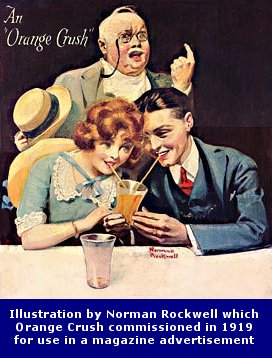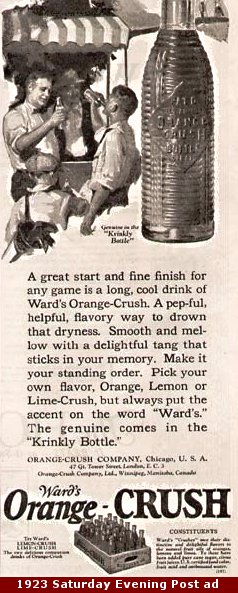 range Crush.’ ”
range Crush.’ ”Thursday, May 25, 2006
Page 15
REMINISCING (Column)
Orange Crush—a Soda Pop Developed in Los Angeles
By ROGER M. GRACE
Coke was invented in Atlanta, Georgia; Pepsi in New Bern, North Carolina; Dr. Pepper in Waco, Texas; 7-Up in St. Louis, Missouri; and Vernor’s Ginger Ale in Detroit, Michigan.
Was any major soft drink first concocted in Los Angeles? Yes. Orange Crush.
Before getting to the product’s local beginnings, here’s what Cadbury-Schweppes—the British Company that now owns Orange Crush and just about every non-cola brand you can think of—says on its website:
“In 1916, Clayton J. Howell, president and founder of the Orange Crush Company, partnered with California chemist Neil C. Ward to incorporate the company. Ward, a beverage and extract chemist, perfected the process of blending ingredients to create the exclusive formula that yielded the zesty, all-natural orange flavor of Orange Crush. J.M. Thompson of Chicago is recognized as the original inventor of Orange Crush in 1906.”
The website continues:
“C. J. Howell was not new to the soft
drink business, having earlier introduced Howell’s Orange Julep. Soft drinks of
the time often carried the surname of the inventor along with the product name.
Howell sold the rights to use his name in conjunction with his first brand; his
partner, Ward, was given the honors and Crush was first premiered as ‘Ward’s
O range Crush.’ ”
range Crush.’ ”
Howel (spelled with one “l”) did form the Orange-Crush Company (incorporated Aug. 16, 1916). A 1917 opinion of the Supreme Court of Missouri shows that he had not been the inventor of “Howel’s Orange Julep”; rather, he had been secretary and manager of the Jersey Creme Company and, in that capacity, oversaw the development of the drink by an employee. The name “Clayton James Howel” had been registered by the company as a trademark in connection with its product and rights to the trademark were assigned by Howel to the company.
Neil Callen Ward was a chemist who had
injured an eye in an explosion. He developed the formula for Orange Crush in
1915, at the age of 34. Ward and his wife lived in an apartment on Virgil
Avenue.
formula for Orange Crush in
1915, at the age of 34. Ward and his wife lived in an apartment on Virgil
Avenue.
There may have been a J.M. Thompson who had developed an earlier product known as “Orange Crush,” but it would appear that Ward’s formulation was unique.
Widespread advertising of Ward’s Orange-Crush got underway in 1919.
An ad appearing in the summer of that year in numerous newspapers said that “[t]he process of preparing Orange-Crush was perfected in Los Angeles—in the midst of the beautiful orange groves of Southern California.”
The ad recounted that the “almost insurmountable difficulty which had to be faced at the start was the quick deterioration of orange-juice.” It could only be preserved by keeping it at a temperature 18 degrees below the freezing point—or one to three degrees above that point if the juice were sterilized, ruining the flavor, according to the ad.
The answer was found to be use of “tiny, fragrant globules of oil artfully concealed in minute cells” in the outer skin of the orange, which contained the “dominant flavor” of the juice.
The ad continued:
“It was only after many patient years of experimenting that the exclusive process, whereby the delicately flavored globules of oil are successfully introduced into the drink, was achieved. The discovery and perfection of this remarkable process was accomplished by N.C. Ward, a soft-drink chemist of national repute. The process is known and used only by Orange-Crush Co. It is the presence of these minute and delicious particles of oil, distributed by the Ward process uniformly throughout the drink which gives the inimitable flavor and the fruit-cloudy appearance to Orange-Crush.”
While the company was headquartered in Chicago, its laboratories were in Los Angeles.
Initially, there was no orange juice in the beverage—only the oil from the skins. But by 1921, juice was added to Orange Crush (as well as to the newer beverages, Lemon Crush and Lime Crush).
A 1924 decision of the U.S. Court of Appeals of the District of Columbia listed what was contained in the Orange Crush bottles:
“A compound prepared from oil of orange, orange juice, citric acid and purest sugar syrup. Colored with harmless food colors.”
Today, by contrast, labels read:
“Carbonated Water, High Fructose Corn Syrup and/or Sugar, Citric Acid, Sodium Benzoate (Preservative), Gum Acacia, Natural Flavors, Glycerol Ester of Wood Rosin, Yellow 6, Salt, Brominated Vegetable Oil, Red 40.”
Wood rosin, but no mention of orange juice.
There will be more about orange sodas next week.
Copyright 2006, Metropolitan News Company